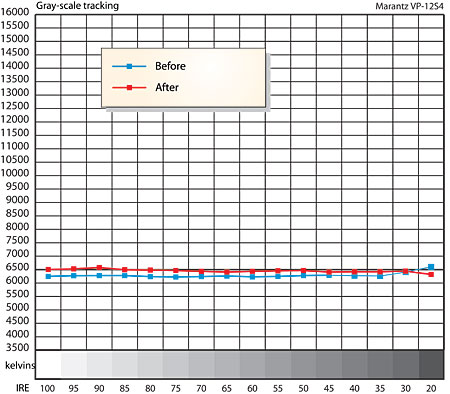Marantz VP-12S4 DLP Projector Additional Tests and Calibration
All measurements were made on my 78-inch wide, 16:9, Stewart Studiotek 130 screen, virtually identical to the screen Shane uses (his Studiotek 130 is just a bit larger than mine, at 80 inches wide).

In its User 3 color temperature setting (shown as the Before measurement in the accompanying chart) the Marantz was a little plus green and just slightly below the optimum color temperature. After calibration, the result was first-rate and very close to the standard D65 color coordinates at every point (a maximum error of +0.003 in the x/y coordinates at 20IRE and even tighter across the rest of the brightness range). The color temperature was acceptably uniform across all the standard input resolutions (480i/p, 720p, and 1080i) for either an HDMI or component source (the only two measured here), but did require different settings for an accurate calibration on each of those inputs. It was a simple matter to save each of these separate calibrations in separate User memories. The calibration went fairly quickly, so doing two of them (provided you have the right test tools) was not significantly more time consuming than doing just one.
The projector's primary color coordinates were satisfactory. Red was actually a little deeper red than either the SD or HD standards call for, and blue was a little less deep into bluish purple than is absolutely correct. But green—to which the eye is most sensitive—was much closer to the correct value than we usually see in a digital projector.
After calibration, and with the contrast and brightness controls set for correct black and maximum white without clipping or gray scale discoloration, I measured a peak contrast of 2650:1 (10.6-foot-Lamberts peak white/0.004fL video black) with the iris on its low f5.0 setting, and 1890 (13.27fL peak white/0.007fL video black) with the iris opened up to f3.0. As Shane notes in the review, the black level at f5.0 was as good as any we have yet measured on any digital projector without a dynamic iris, though the 10.6fL the maximum brightness wasn't generous (with just over 350 hours on the lamp). The Marantz might not be the best choice for a much larger screen—but I've found that to be true of most single-chip DLP projectors that offer the deepest black levels. At an iris setting of f3.0 the image has a little more pop at the top end, though the peak contrast ratio degrades slightly due to the higher black level.
My measurements also indicate that the gamma of the Marantz (Theater gamma, with the iris in the f3.0 setting) was a bit low at about 1.9. This will make the image a bit lighter than ideal in the midrange, just as Shane observed. —TJN




























































